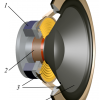Whenever you listen to music, whether it is with your phone, iPod, or computer, you are using magnets. Technically, the speakers that are transmitting the music are using magnets. Rare earth magnets can be found in any audio speaker set, even in headphones. The permanent magnet in speakers acts as an electromagnet when an electric current is applied through a coil of wire. You can make your own set of speakers out of virtually anything━as long as you have a magnet and few other small items. Here are some unusual ways that you can fashion your own speakers:
Paper Plate
In a previous blog, we showed you how to make speakers with 6 easy-to-find supplies: a paper plate, a strong rare earth magnet, copper wire, tape, cardboard and audio plugs. This may not be the fanciest looking pair of speakers you could create, but it is a great starter kit for those making their first set. It also makes for an inexpensive and interesting science experiment on electricity and magnetism. Learn how to make your own
with our blog.
Red Solo Cup
Making an
audio speaker from a solo cup, or really any plastic or styrofoam cup is similar to making it from a paper plate. You can make a variation from the simple solo cup speaker that uses one cup by using multiple cups. In order to use more than one cup, you’ll need a way to connect them, which you can do with an old paper towel roll. You can cut a hole in the towel roll to hold a phone and two holes in each cup to put the roll through. This also can amplify the sound from your phone speakers without needing any magnets or other supplies. However, if you want some extra volume, you can use the paper plate speaker tutorial and attach a magnet to the cups.
Jungle Leaf
We found this neat DIY on
Instructables that shows you how to make speakers from something that you can find almost anywhere--a leaf. The leaf should be rolled so that it is in a cone shape, similar to a megaphone. The sound from your listening device will bounce off and travel from the leaf and amplify it.
These are just a few examples of materials that you can use to make your own set of speakers, but there are many other ways. The neat part about each is that the diaphragm, or cone-shaped, part can vary to anything. As long as you use the correct magnet and electronics parts for it to operate, the possibilities are virtually limitless.
Photo by
Svjo
